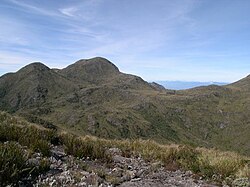Brazilian Highlands | |
|---|---|
 Pedra da Mina, a mountain in the state of São Paulo, in 1997 | |
 Topographic map of Brazil. The Brazilian Highlands/Plateau is the large yellowish and brown area in the east, south and center of the country. | |
| Location | Caatinga and Cerrado, Brazil |
| Area | |
| • Total | 5,000,000 km2 (1,900,000 sq mi) |
| Dimensions | |
| • Length | 3,500 km (2,200 mi), SW x NE |
| Highest elevation | 2,891 m (9,485 ft) |
The Brazilian Highlands or Brazilian Plateau (Portuguese: Planalto Brasileiro) is an extensive geographical region covering most of the eastern, southern and central portions of Brazil, in all some 4,500,000 km2 (1,930,511 sq mi) or approximately half of the country's land area.[1][2] The vast majority of Brazil's population (203.062.512; 2022 census) lives in the highlands or on the narrow coastal region immediately adjacent to it.
Ancient basaltic lava flows gave birth to much of the region. However, the time of dramatic geophysical activity is long past, as there is now no seismic or volcanic activity. Erosion has also played a large part in shaping the Highlands, forming extensive sedimentary deposits and wearing down the mountains.
The Brazilian Highlands are recognized for its great diversity: within the region there are several different biomes, vastly different climatic conditions, many types of soil, and thousands of animal and plant species.
